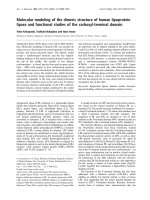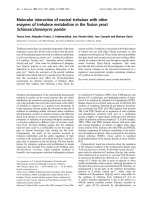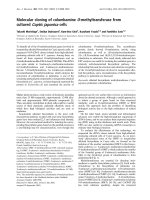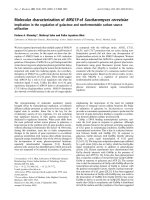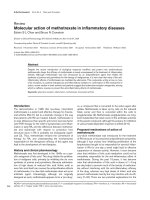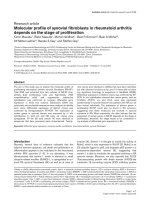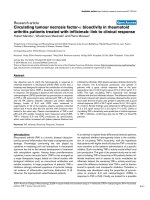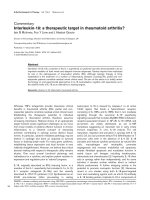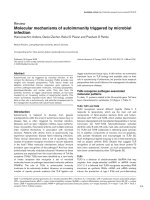Báo cáo y học: "Molecular profile of synovial fibroblasts in rheumatoid arthritis depends on the stage of proliferation" potx
Bạn đang xem bản rút gọn của tài liệu. Xem và tải ngay bản đầy đủ của tài liệu tại đây (958.48 KB, 7 trang )
Introduction
Recently, several lines of evidence indicated that the
balance between apoptotic cell death and proliferation or
differentiation appears to be modulated in the rheumatoid
arthritis (RA) synovium [1–3]. In our laboratory, it was
demonstrated that sentrin-1, which is identical to small
ubiquitin-related modifier (SUMO)-1, is upregulated in cul-
tured RA synovial fibroblasts (SF) as well as at sites of
invasion [4]. Sentrin-1 is thought to modify the activity of
Mdm2, which is also expressed in RA-SF [5]. Mdm2 is an
E3 ubiquitin ligase for p53, and degrades p53 protein in a
proteasome-dependent manner [6], suggesting that
sentrin-1 is able to modulate the apoptotic pathway in RA
synovial tissues. Moreover, we also reported that FLICE
(Fas-associating protein with death domain [FADD]-like
interleukin 1β converting enzyme [ICE]) inhibitory protein
13kdap = 13kDa differentiation-associated protein; Apaf-1 = apoptotic protease-activating factor-1; AZI = antizyme inhibitor; BCIP = 5-bromo-4-
chloro-3-indolyl-phosphate, 4-toluidine salt; ECM = extracellular matrix; EFEMP1 = EGF-containing fibulin-like extracellular matrix protein 1; EPLIN =
epithelial protein lost in neoplasm; Fbx3 = F-box only protein 3; FLICE = Fas-associating protein with death domain [FADD]-like interleukin 1β con-
verting enzyme [ICE]; FLIP = FLICE inhibitory protein; HD = high-density; HE = hematoxylin and eosin; LD = low-density; NAP1L1 = nucleosome
assembly protein 1-like 1; NBT = 4-nitro blue tetrazolium chloride; NCBI = National Center for Biotechnology Information; NFAT5 = nuclear factor
of activated T cells 5; PCNA = proliferating cell nuclear antigen; PDGF = platelet-derived growth factor; RA = rheumatoid arthritis; RNASE4 =
ribonuclease 4; RT-PCR = reverse transcriptase-polymerase chain reaction; S100A4 = S100 calcium-binding protein A4; SF = synovial fibroblasts;
SUMO = small ubiquitin-related modifier; unr = upstream of N-ras.
Available online />Research article
Molecular profile of synovial fibroblasts in rheumatoid arthritis
depends on the stage of proliferation
Kimio Masuda
1
, Riako Masuda
1
, Michel Neidhart
1
, Beat R Simmen
2
, Beat A Michel
3
,
Ulf Müller-Ladner
4
, Renate E Gay
1
and Steffen Gay
1
1
Center of Experimental Rheumatology and WHO Collaborating Center for Molecular Biology and Novel Therapeutic Strategies for Rheumatic
Diseases, Department of Rheumatology, University Hospital Zürich, Gloriastrasse 25, CH-8091 Zürich, Switzerland
2
Upper Extremity and Handsurgery, Schulthess Clinic, Lengghalde 2, CH-8008 Zürich, Switzerland
3
Department of Rheumatology, University Hospital Zürich, Gloriastrasse 25, CH-8091 Zürich, Switzerland
4
Department of Internal Medicine I, University of Regensburg, D-93042 Regensburg, Germany
Corresponding author: Steffen Gay (e-mail: )
Received: 15 March 2002 Revisions received: 6 June 2002 Accepted: 21 June 2002 Published: 17 July 2002
Arthritis Res 2002, 4:R8
© 2002 Masuda et al., licensee BioMed Central Ltd (Print ISSN 1465-9905; Online ISSN 1465-9913)
Abstract
The aim of this study was to explore the molecular profile of
proliferating rheumatoid arthritis synovial fibroblasts (RA-SF).
Total RNA was extracted from two cultures of RA-SF (low-
density [LD] proliferating cells and high-density [HD]
nonproliferating cells) and suppression subtractive
hybridization was performed to compare differential gene
expression of these two cultures. Subtracted cDNA was
subcloned, and nucleotide sequences were analyzed to identify
each clone. Differential expression of distinct clones was
confirmed by semiquantitative RT-PCR. The expression of
certain genes in synovial tissues was examined by in situ
hybridization. In both LD and HD cells, 44 clones were
upregulated. Of the 88 total clones, 46 were identical to
sequences that have previously been characterized. Twenty-
nine clones were identical to cDNAs that have been identified,
but with unknown functions so far, and 13 clones did not show
any significant homology to sequences in GenBank (NCBI).
Differential expression of distinct clones was confirmed by RT-
PCR. In situ hybridization showed that certain genes, such as
S100A4, NFAT5, unr and Fbx3, were also expressed
predominantly in synovial tissues from patients with RA but not
from normal individuals. The expression of distinct genes in
proliferating RA-SF could also be found in RA synovium,
suggesting that these molecules are involved in synovial
activation in RA. Most importantly, the data indicate that the
expression of certain genes in RA-SF depends on the stage of
proliferation; therefore, the stage needs to be considered in
any analysis of differential gene expression in SF.
Keywords: differential gene expression, molecular profile, proliferation, rheumatoid arthritis, synovial fibroblasts
Page 1 of 7
(page number not for citation purposes)
Page 2 of 7
(page number not for citation purposes)
Arthritis Research Vol 4 No 5 Masuda et al.
(FLIP), an inhibitor of caspase 8, is expressed predomi-
nantly at sites of bone and cartilage destruction in RA [7].
These results indicate that several anti-apoptotic mecha-
nisms most likely play a critical role in maintaining the
long-term activation of RA-SF and thereby contribute to
matrix degradation.
In addition to the expression of these anti-apoptotic mole-
cules, RA-SF show several features with regard to cell
proliferation. Lafyatis et al. [8] reported that RA-SF reveal
anchorage-independent cell growth under certain culture
conditions, such as high serum concentration (20%) or
platelet-derived growth factor (PDGF) supplementation.
Moreover, it has been shown that PDGF and PDGF
receptor [9], c-myc [10,11] and proliferating cell nuclear
antigen (PCNA) [10], which are cell proliferation-associ-
ated molecules, are predominantly expressed in rheuma-
toid synovium.
On the basis of these observations, we hypothesized that
proliferating RA-SF express a specific set of genes that pro-
motes proliferation and/or inhibits the apoptotic process.
Thus, the aim of this study was to investigate the expression
profile of RA-SF during proliferation in comparison with that
of nonproliferating RA-SF, and thereby to explore novel mol-
ecular mechanisms of synovial proliferation in RA.
Materials and methods
Preparation of synovial fibroblasts
Cultured RA-SF from one patient (SHK70) who fulfilled
the 1987 revised criteria of the American College of
Rheumatology for the disease were propagated from syn-
ovial tissue obtained during synovectomy, and were used
for cDNA subtraction. Briefly, the tissue specimens were
minced enzymatically, and the adherent cells were cul-
tured in Dulbecco’s modified Eagle’s medium (Life Tech-
nologies AG, Basel, Switzerland) supplemented with 10%
fetal calf serum. The cells were cultured until reaching
confluence, then trypsinized and spread to new culture
flasks in a 1:5 dilution. The cells were cultured for the sixth
passage, and the cells in passage six were used for sup-
pression subtractive hybridization. Two other RA-SF from
different patients with RA (SHK78 and SHK80) were also
used for RT-PCR.
RNA isolation and suppression subtractive hybridization
Total RNA was extracted with TRIZOL
®
reagent (Life
Technologies AG, Basel, Switzerland) from two cultures, 4
days after seeding (LD; low-density cells) and 14 days
after seeding (HD; high-density cells), respectively (see
Supplementary material). From each culture, 1 µg of total
RNA was used for cDNA synthesis with the SMART™
PCR cDNA Synthesis Kit (BD Clontech, Basel, Switzer-
land), and suppression subtractive hybridization was per-
formed with the PCR-Select™ cDNA Subtraction Kit (BD
Clontech, Basel, Switzerland) according to the manufac-
turer’s instructions. We performed two directional subtrac-
tions. In the forward (LD-specific) subtraction, we investi-
gated the genes specifically expressed on day 4 in
proliferating cells at low density. We also conducted
reverse (HD-specific) subtraction to analyze the genes
predominantly expressed on day 14 in nonproliferating
cells at high density. Each subtracted cDNA was sub-
cloned into PCR-Script Amp SK (+) cloning vector (Strat-
agene Europe, Amsterdam, The Netherlands). After
plasmid DNA of each clone was purified using Concert™
Rapid Plasmid Purification Systems (Life Technologies
AG, Basel, Switzerland), the nucleotide sequences were
analyzed by commercial sequencing (Microsynth, Balgach,
Switzerland), and BLAST searches (NCBI) were per-
formed to identify the respective gene of each clone.
Semiquantitative RT-PCR
We designed primers specific for distinct genes, i.e.
antizyme inhibitor (AZI), EGF-containing fibulin-like extra-
cellular matrix protein 1 (EFEMP1), S100 calcium-binding
protein A4 (S100A4), nuclear factor of activated T cells 5
(NFAT5), upstream of N-ras (unr), F-box only protein 3
(Fbx3), ribonuclease 4 (RNASE4), dipeptidylpeptidase IV
(CD26), epithelial protein lost in neoplasm (EPLIN) and
13 kDa differentiation-associated protein (13kdap). Then,
mRNA expression was analyzed by semiquantitative
RT-PCR to confirm the differential expression of the sub-
tracted cDNA. At first, template cDNA was diluted 1: 3
and 1: 9, and PCR with primers of housekeeping genes
such as actin
β
and glyceraldehyde-3-phosphate dehydro-
genase (GAPDH) was performed to compare the equal
amounts of cDNA between two cultures in further experi-
ments. Then, the efficiency of the amplification and the
optimal cycles were confirmed for each set of primers.
After this optimization, we compared the expression of
each gene. All PCR reactions consisted of initial denatura-
tion at 94°C for 10 min followed by 25 to 35 cycles at
94°C for 30 s, 58 to 60°C for 1 min, and 72°C for 90 s
performed by using AmpliTaq Gold
®
DNA polymerase and
GeneAmp PCR system 9700 (Applied Biosystems,
Rotkreuz, Switzerland). PCR products were analyzed on
1.0% agarose gels.
In situ
hybridization
The expression and distribution of distinct genes were
examined in paraffin-embedded sections of synovial
tissues from seven patients with RA and three normal indi-
viduals by in situ hybridization with digoxigenin-labeled
RNA probes, which were generated by in vitro transcrip-
tion with T3 or T7 RNA polymerases. The probes were
detected with alkaline-phosphatase-conjugated anti-digox-
igenin antibody F (ab), and visualized with 4-nitro blue
tetrazolium chloride (NBT) and 5-bromo-4-chloro-3-
indolyl-phosphate, 4-toluidine salt (BCIP) solutions
(Roche Diagnostics, Rotkreuz, Switzerland). In each
experiment, we counted the number of positive cells in the
Page 3 of 7
(page number not for citation purposes)
lining of synovial tissues, and the levels of mRNA expres-
sion were calculated as a percentage of positive cells.
Results
Identification of subtracted cDNA
We obtained 44 clones that were upregulated in LD cells
and 44 clones that were upregulated in HD cells (Figs 1
and 2). Forty-six of the 88 clones were identical to
sequences that have previously been identified and char-
acterized. Twenty-nine clones were identical to cDNAs
that have been identified, but with unknown functions so
far, and 13 gene fragments did not show any significant
homology to sequences in the GenBank (NCBI). In LD-
specific clones, there were several extracellular matrix
(ECM) proteins such as EFEMP1, fibrillin, versican, laminin
and fibronectin. There were also some proliferation-related
molecules such as AZI, Fbx3 and nucleosome assembly
protein 1-like 1 (NAP1L1), or cell-activation-associated
molecules such as S100A4 and NFAT5 (Fig. 1). On the
other hand, in HD-specific clones, there were several mol-
ecules that induce protein synthesis, such as ribosomal
proteins. We also found the expression of some differenti-
ation markers such as 13kdap and CD26 and genes
associated with inhibition of cell growth, such as EPLIN
and RNASE4 (Fig. 2). We confirmed the efficiency of sub-
traction by PCR according to the manufacturer’s instruc-
tions (data not shown).
Confirmation of differential expression of distinct genes
The LD-specific genes such as EFEMP1, unr and Fbx3
(Fig. 3a), and the HD-specific genes such as CD26,
13kdap and RNASE4 (Fig. 3b) were upregulated in LD
and HD cells, respectively. These results indicated that
the subtracted cDNA represented the part of genes actu-
ally expressed in a culture condition-dependent manner.
The results of actin-β and GAPDH indicated that we com-
pared equal amounts of template cDNA in these experi-
ments (Fig. 3c).
Expression of distinct genes
in situ
We investigated the expression and distribution of distinct
genes, namely S100A4, NFAT5, Fbx3 and unr, all of
which were upregulated in LD cells, by in situ hybridiza-
tion. S100A4 mRNA was expressed both in the lining and
sublining layer of RA synovium (Fig. 4). The same expres-
sion pattern was shown by unr (see Supplementary mater-
ial). We also detected the expression of NFAT5 mRNA in
RA synovium (Fig. 5). Interestingly, NFAT5, as well as
Fbx3, mRNA was also expressed at sites of bone destruc-
tion (Fig. 6 and see Supplementary material). These
results indicate that NFAT5 and Fbx3 could be correlated
not only with the proliferation but also with the activation
and invasion of RA-SF in vivo. It is noteworthy that these
four genes (i.e. S100A4, unr, NFAT5, Fbx3) were pre-
dominantly expressed in synovial tissues from patients
with RA rather than from normal individuals (see Supple-
mentary material), suggesting that these genes could con-
tribute to the pathogenesis of RA.
Discussion
We analyzed the expression profile of proliferating RA-SF
in comparison with that of nonproliferating RA-SF, and we
observed that distinct sets of genes, including several
novel genes that have not been associated with RA, were
expressed differentially in proliferating RA-SF by using a
PCR-based suppression subtractive hybridization technique.
Available online />Figure 1
The list of clones obtained by forward (LD-specific) subtraction. We
divided these clones into three categories. (a) This category consists
of already identified and characterized genes. (b) This category
includes the genes with sequences previously identified, but with
unknown functions so far. The name of each clone is shown. (c) List of
novel gene fragments that did not show any significant homology to
sequences in GenBank (NCBI). We mention just the name of clones in
our experiments.
Antizyme inhibitor
F-box only protein 3 (Fbx3)
Nucleosome assembly protein 1-like 1
Lysosome-associated membrane protein 2
EGF-containing fibulin-like extracellular
matrix protein 1 (EFEMP1)
Fibrillin 1
Versican
Laminin γ 1
Fibronectin
Aldose reductase
S100 calcium-binding protein A4 (S100A4)
Semaphorin E
Pepstatin-insensitive lysosomal peptidase
Dihydrodiol dehydrogenase 2
Lactate dehydrogenase B
Nuclear factor of activated T cells 5 (NFAT5)
Upstream of N-ras (unr)
FBR35
KIAA0143
335E3
KAT05223
RP1-187N21
KIAA0093
RP1-242G1
LOC51065
A9A2BRB5
HP10085
KIAA1562
KIAA0660
RP1-86D1
PLACE1001168
LDS6
LDS7
LDS8
LDS12
LDS14
LDS17
LDS34
LDS43
(a)
(b)
(c)
Figure 2
The list of clones obtained by reverse (HD-specific) subtraction. We
divided these clones into the same three categories as described in
Figure 1.
(a)
(b)
(c)
FLB8331
HSPC241
HEP01486
TSAP19
KAIA2887
DKFZp586H0523
KAT08245
RP11-48B24
RP11-467H10
KIAA1128
RP11-467P9
RP4-541C22
KAT05659
HDS8
HDS12
HDS34
HDS37
HDS41
Glutamine synthetase
Ribosomal protein S4 X-linked
Ribosomal protein L32
Ribosomal protein L23
13 kDa differentiation associated protein
Calmodulin I
Tumor-associated antigen L6
Small nuclear ribonucleoprotein
polypeptide B“
Tomoregulin
CDC10
CD26
Glucocorticoid receptor
Dynein
Ubiquitin conjugating enzyme E2A
Staufen
Epithelial protein lost in neoplasm (EPLIN)
RNASE 4
It is useful for development of novel therapeutic
approaches to identify the expression profiles in disease-
associated cells or conditions [12,13], and there are some
reports that identified genes specifically expressed in
rheumatoid synovial cells by using a cDNA subtraction or
a differential display method [14–17]. Since we used RA-
SF from the same patient, at the same passage and cul-
tured with the same medium, we could exclude genetic
polymorphism between individuals, and could identify spe-
cific genes dependent on proliferation or cell density.
In LD-specific subtracted cDNA, we isolated several inter-
esting molecules that play an important role in cell prolifera-
tion. For example, we found upregulation of several ECM
proteins. ECM proteins not only serve just as a mechanical
structure, but also play an important role in many biological
functions, such as cell migration, proliferation and differen-
tiation [18]. Indeed, it was reported that versican stimulates
cell proliferation [19,20], and EFEMP1 stimulates DNA
synthesis when microinjected into fibroblasts [21].
Fibronectin fragments play an important role in proliferation,
Arthritis Research Vol 4 No 5 Masuda et al.
Page 4 of 7
(page number not for citation purposes)
Figure 3
The differential expression of distinct genes. It was confirmed by semiquantitative RT-PCR. (a) LD-specific genes such as EFEMP1, unr and Fbx3,
and (b) HD-specific genes such as CD26, 13kdap and RNASE4 were upregulated in LD and HD cells, respectively. (c) The results of actin-β and
GAPDH indicated that we compared equal amounts of template cDNA in these experiments. We analyzed three independent RA-SF and show the
representative results.
1 1:3 1:9
LD
(a)
(c)
(b)
Actin-β
G3PDH
unr
RNASE4
13kdap
CD26
Fbx3
EFEMP1
1 1:3 1:9
HD
1 1:3 1:9
LD
1 1:3 1:9
HD
1 1:3 1:9
LD
1 1:3 1:9
HD
Figure 4
The expression of S100A4 mRNA in sections from patients with RA by
in situ hybridization. This figure shows antisense (a,b) and sense (c)
staining, respectively. We also performed HE staining (d) in serial
sections. The original magnifications are 200× (a,c,d) and 400× (b),
respectively.
Figure 5
The expression of NFAT5 mRNA in sections from patients with RA by
in situ hybridization. This figure shows antisense (a,b) and sense (c)
staining, respectively. We also performed HE staining (d) in serial
sections. The original magnifications are 100× (a,c,d) and 200× (b),
respectively.
adhesion and matrix metalloproteinase expression of RA-
SF [22]. The expression of ECM proteins in proliferating
RA-SF, therefore, could stimulate their proliferation and dif-
ferentiation in an autocrine and/or paracrine manner.
The expression of proliferation-related molecules such as
AZI, Fbx3 and NAP1L1 was also observed in LD cells.
AZI induces polyamine synthesis, which is essential for
cell growth [23,24], and it was reported that AZI is differ-
entially expressed in tumor tissues rather than normal
tissues [25]. Although the function of Fbx3 has not been
identified so far, F-box proteins are important for control-
ling the cell cycle [26]. Simon et al. [27] demonstrated
that NAP1L1 is highly expressed in proliferating cells. On
the other hand, unr was also highly expressed in LD cells,
and it was reported that unr interacts with apoptotic pro-
tease-activating factor-1 (Apaf-1) and could modulate a
certain apoptotic pathway [28]. We can hypothesize,
therefore, that these molecules are not only essential for
cell survival and proliferation in general, but could also
play an important role in the proliferation of RA-SF in vitro
and in vivo.
In HD-specific subtracted cDNA, we also obtained several
interesting molecules. Indeed, we found that CD26,
EPLIN and RNASE4 were specifically expressed in non-
proliferating RA-SF. CD26 was originally identified as an
adenosine deaminase complexing protein and T-cell acti-
vation molecule, and it was reported that activated T cells
as well as fibroblasts in rheumatoid synovium expressed
this molecule [29]. Recently, it was shown that the malig-
nant phenotype of melanoma cells is suppressed by the
introduction of the exogenous CD26 gene [30]. EPLIN is
downregulated or lost in cancer cell lines and inhibits cell
proliferation when overexpressed [31,32]. On the other
hand, RNASE 4 mediates the antiviral and antiproliferative
roles of interferons and is induced during growth inhibition
in murine cell lines [33]. Recently, Taniguchi et al. [34]
showed that cyclin-dependent kinase inhibitor p16
INK4a
is
induced in RA-SF by several growth-inhibited conditions,
including irradiation, serum depletion and high cellular
density. Surprisingly, they showed also that the gene
transfer of p16 inhibits proliferation of synovial fibroblasts
in vitro and suppresses rat adjuvant arthritis in vivo. In this
context, EPLIN and RNASE4 genes might also be promis-
ing candidates for gene transfer as a novel approach to
treating RA.
Conclusion
We demonstrated that proliferating RA-SF express a dis-
tinct set of genes clearly different from that of nonproliferat-
ing RA-SF. Moreover, a number of molecules correlated
with cell proliferation and activation, including several novel
genes, were isolated from RA-SF by using suppression
subtractive hybridization. Cooperating with anti-apoptotic
molecules such as sentrin-1 and FLIP, these molecules
could be involved in synovial cell proliferation and activation
and could contribute to matrix destruction at sites of inva-
sion in RA. Last but not least, a consideration of cell
density should be mandatory in any investigation examining
cell proliferation or apoptosis in cell cultures.
Acknowledgements
We would like to thank M Commazi, P Künzler and F Pataky for their
technical assistance and G Pairo for the secretarial work. K Masuda is
supported by the Japan Rheumatism Foundation, R Masuda by the
Uehara Memorial Foundation and the other authors by their institutions.
References
1. Firestein GS, Echeverri F, Yeo M, Zvaifler NJ, Green DR: Somatic
mutations in the p53 tumor suppressor gene in rheumatoid
arthritis synovium. Proc Natl Acad Sci USA 1997, 94:10895-
10900.
2. Han Z, Boyle DL, Shi Y, Green DR, Firestein GS: Dominant-neg-
ative p53 mutations in rheumatoid arthritis. Arthritis Rheum
1999, 42:1088-1092.
3. Matsumoto S, Muller-Ladner U, Gay RE, Nishioka K, Gay S: Ultra-
structural demonstration of apoptosis, Fas and Bcl-2 expres-
sion of rheumatoid synovial fibroblasts. J Rheumatol 1996, 23:
1345-1352.
4. Franz JK, Pap T, Hummel KM, Nawrath M, Aicher WK, Shigeyama
Y, Muller-Ladner U, Gay RE, Gay S: Expression of sentrin, a
novel antiapoptotic molecule, at sites of synovial invasion in
rheumatoid arthritis. Arthritis Rheum 2000, 43:599-607.
5. Muller-Ladner U, Nishioka K: p53 in rheumatoid arthritis: friend
or foe? Arthritis Res 2000, 2:175-178.
6. Buschmann T, Fuchs SY, Lee CG, Pan ZQ, Ronai Z: SUMO-1
modification of Mdm2 prevents its self-ubiquitination and
increases Mdm2 ability to ubiquitinate p53. Cell 2000, 101:
753-762.
7. Schedel J, Gay RE, Simmen B, Gay S: Flice-inhibitory protein
(FLIP) expression at sites of cartilage and bone destruction in
rheumatoid arthritis (RA) [abstract]. Arthritis Rheum 2000, 43:
s160.
8. Lafyatis R, Remmers EF, Roberts AB, Yocum DE, Sporn MB,
Wilder RL: Anchorage-independent growth of synoviocytes
from arthritic and normal joints. Stimulation by exogenous
Available online />Page 5 of 7
(page number not for citation purposes)
Figure 6
The expression of NFAT5 mRNA in sections from patients with RA by
in situ hybridization. This figure shows antisense (a,b) and sense (c)
staining, respectively. The positive signal was observed not only in
fibroblast-like cells (arrowheads) but also in osteoclast-like cells
(arrows). We also performed HE staining (d) in serial sections. The
original magnifications are 200× (a,c,d) and 400× (b), respectively.
platelet-derived growth factor and inhibition by transforming
growth factor-beta and retinoids. J Clin Invest 1989, 83:1267-
1276.
9. Remmers EF, Sano H, Wilder RL: Platelet-derived growth
factors and heparin-binding (fibroblast) growth factors in the
synovial tissue pathology of rheumatoid arthritis. Semin Arthri-
tis Rheum 1991, 21:191-199.
10. Qu Z, Garcia CH, O’Rourke LM, Planck SR, Kohli M, Rosenbaum
JT: Local proliferation of fibroblast-like synoviocytes con-
tributes to synovial hyperplasia. Results of proliferating cell
nuclear antigen/cyclin, c-myc, and nucleolar organizer region
staining. Arthritis Rheum 1994, 37:212-220.
11. Trabandt A, Aicher WK, Gay RE, Sukhatme VP, Nilson-Hamilton
M, Hamilton RT, McGhee JR, Fassbender HG, Gay S: Expres-
sion of the collagenolytic and Ras-induced cysteine pro-
teinase cathepsin L and proliferation-associated oncogenes
in synovial cells of MRL/I mice and patients with rheumatoid
arthritis. Matrix 1990, 10:349-361.
12. Liotta L, Petricoin E: Molecular profiling of human cancer. Nat
Rev Genet 2000, 1:48-56.
13. St Croix B, Rago C, Velculescu V, Traverso G, Romans KE, Mont-
gomery E, Lal A, Riggins GJ, Lengauer C, Vogelstein B, Kinzler
KW: Genes expressed in human tumor endothelium. Science
2000, 289:1197-1202.
14. Justen HP, Grunewald E, Totzke G, Gouni-Berthold I, Sachinidis
A, Wessinghage D, Vetter H, Schulze-Osthoff K, Ko Y: Differen-
tial gene expression in synovium of rheumatoid arthritis and
osteoarthritis. Mol Cell Biol Res Commun 2000, 3:165-172.
15. Mangasser-Stephan K, Dooley S, Welter C, Mutschler W, Hansel-
mann RG: Identification of human semaphorin E gene expres-
sion in rheumatoid synovial cells by mRNA differential
display. Biochem Biophys Res Commun 1997, 234:153-156.
16. Seki T, Selby J, Haupl T, Winchester R: Use of differential sub-
traction method to identify genes that characterize the pheno-
type of cultured rheumatoid arthritis synoviocytes. Arthritis
Rheum 1998, 41:1356-1364.
17. Zanders ED, Goulden MG, Kennedy TC, Kempsell KE: Analysis
of immune system gene expression in small rheumatoid
arthritis biopsies using a combination of subtractive
hybridization and high-density cDNA arrays. J Immunol
Methods 2000, 233:131-140.
18. Schuppan D, Somasundaram R, Dieterich W, Ehnis T, Bauer M:
The extracellular matrix in cellular proliferation and differenti-
ation. Ann NY Acad Sci 1994, 733:87-102.
19. Yang BL, Zhang Y, Cao L, Yang BB: Cell adhesion and prolifer-
ation mediated through the G1 domain of versican. J Cell
Biochem 1999, 72:210-220.
20. Zhang Y, Cao L, Yang BL, Yang BB: The G3 domain of versican
enhances cell proliferation via epidermial growth factor-like
motifs. J Biol Chem 1998, 273:21342-21351.
21. Lecka-Czernik B, Lumpkin CK Jr, Goldstein S: An overexpressed
gene transcript in senescent and quiescent human fibroblasts
encoding a novel protein in the epidermal growth factor-like
repeat family stimulates DNA synthesis. Mol Cell Biol 1995,
15:120-128.
22. Barilla ML, Carsons SE: Fibronectin fragments and their role in
inflammatory arthritis. Semin Arthritis Rheum 2000, 29:252-
265.
23. Hayashi S, Murakami Y: Rapid and regulated degradation of
ornithine decarboxylase. Biochem J 1995, 306:1-10.
24. Nilsson J, Grahn B, Heby O: Antizyme inhibitor is rapidly
induced in growth-stimulated mouse fibroblasts and releases
ornithine decarboxylase from antizyme suppression. Biochem
J 2000, 346 Pt 3:699-704.
25. Jung MH, Kim SC, Jeon GA, Kim SH, Kim Y, Choi KS, Park SI, Joe
MK, Kimm K: Identification of differentially expressed genes in
normal and tumor human gastric tissue. Genomics 2000, 69:
281-286.
26. Winston JT, Koepp DM, Zhu C, Elledge SJ, Harper JW: A family
of mammalian F-box proteins. Curr Biol 1999, 9:1180-1182.
27. Simon HU, Mills GB, Kozlowski M, Hogg D, Branch D, Ishimi Y,
Siminovitch KA: Molecular characterization of hNRP, a cDNA
encoding a human nucleosome- assembly-protein-I-related
gene product involved in the induction of cell proliferation.
Biochem J 1994, 297:389-397.
28. Mitchell SA, Brown EC, Coldwell MJ, Jackson RJ, Willis AE:
Protein factor requirements of the Apaf-1 internal ribosome
entry segment: roles of polypyrimidine tract binding protein
and upstream of N-ras. Mol Cell Biol 2001, 21:3364-3374.
29. Kubota T, Williams YN, Baba H, Nosaka Y, Sugita T, Miyasaka N:
Highly expressed dipeptidyl peptidase IV on fibroblast-like
synoviocytes as well as activated helper T cells could be a
target of RA therapy [abstract]. Arthritis Rheum 2001, 44:s88.
30. Wesley UV, Albino AP, Tiwari S, Houghton AN: A role for dipep-
tidyl peptidase IV in suppressing the malignant phenotype of
melanocytic cells. J Exp Med 1999, 190:311-322.
31. Chang DD, Park NH, Denny CT, Nelson SF, Pe M: Characteriza-
tion of transformation related genes in oral cancer cells.
Oncogene 1998, 16:1921-1930.
32. Maul RS, Chang DD: EPLIN, epithelial protein lost in
neoplasm. Oncogene 1999, 18:7838-7841.
33. Jacobsen H, Krause D, Friedman RM, Silverman RH: Induction of
ppp(A2’p)nA-dependent RNase in murine JLS-V9R cells
during growth inhibition. Proc Natl Acad Sci USA 1983, 80:
4954-4958.
34. Taniguchi K, Kohsaka H, Inoue N, Terada Y, Ito H, Hirokawa K,
Miyasaka N: Induction of the p16INK4a senescence gene as a
new therapeutic strategy for the treatment of rheumatoid
arthritis. Nat Med 1999, 5:760-767.
Correspondence
Prof Dr Steffen Gay, Center of Experimental Rheumatology and WHO
Collaborating Center for Molecular Biology and Novel Therapeutic
Strategies for Rheumatic Diseases, Department of Rheumatology, Uni-
versity Hospital Zürich, Gloriastrasse 25, CH-8091 Zürich, Switzer-
land. Tel +41 1 255 5737; fax +41 1 255 4170; e-mail:
Supplementary material
Arthritis Research Vol 4 No 5 Masuda et al.
Page 6 of 7
(page number not for citation purposes)
Supplementary Figure 1
The strategy of our experiments. SF from one patient with RA
(passage 6) were cultured in 75 cm
2
flasks until reaching confluence.
Then, these cells were collected and seeded in 12-well culture plates
(1.0 × 10
5
cells/well). At 1, 2, 4, 7, 10 and 14 days after seeding, the
number of cells was counted by the trypan blue exclusion method. At
4 days, the cells at low density (LD) proliferated exponentially, and at
14 days, the cells at high density (HD) almost ceased to proliferate as
a result of contact inhibition. The inserts show the HE staining of SF on
chamber slides at 4 and 14 days after seeding, respectively.
Available online />Page 7 of 7
(page number not for citation purposes)
Supplementary Figure 2
The expression of unr mRNA in sections from patients with RA as
shown by in situ hybridization. This figure shows antisense (a,b) and
sense (c) staining, respectively. We also performed HE staining (d) in
serial sections. The original magnifications are 200× (a,c,d) and 400×
(b), respectively.
Supplementary Figure 3
The expression of Fbx3 mRNA in sections from patients with RA as
shown by in situ hybridization. This figure shows antisense (a,b) and
sense (c) staining, respectively. We also performed HE staining (d) in
serial sections. The original magnifications are 100× (a,c,d) and 400×
(b), respectively.
Supplementary Figure 4
The expression of Fbx3 mRNA in sections from patients with RA by in
situ hybridization. This figure shows antisense (a,b) and sense (c)
staining, respectively. The positive signal was observed not only in
fibroblast-like cells (arrowheads) but also in osteoclast-like cells
(arrow). We also performed HE staining (d) in serial sections. The
original magnifications are 200× (a,c,d) and 400× (b), respectively.
Supplementary Figure 5
Summary of the expression of LD-specific genes in synovial tissues
from patients with RA (᭹) and from normal individuals (᭺). In each
experiment, we counted the number of positive cells in the lining of
synovial tissues, and the levels of the mRNA expression were
calculated as a percentage of positive cells. Then, we divided these
data into three groups; namely, below 10% (Low), from 10 to 50%
(Moderate) and more than 50% (High).
Low Moderate High
S100A4
᭹᭹᭹᭹ ᭹᭹ ᭹
᭺᭺᭺
unr
᭹᭹ ᭹᭹ ᭹᭹᭹
᭺᭺ ᭺
NFAT5
᭹᭹᭹᭹᭹᭹᭹
Fbx3
᭹᭹ ᭹ ᭹᭹᭹᭹
᭺᭺ ᭺
